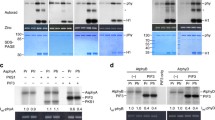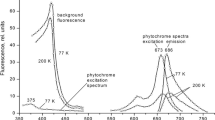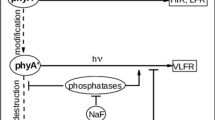Abstract
“Killer”, a substance extracted from stem tissue of etiolated pea seedlings (Pisum sativum L. v. Alaska), interacts specifically with the far-red-absorbing form of phytochrome (Pfr) in vitro in a temperature-independent, rapid, stoichiometric fashion to cause a loss of phytochrome photoreversibility. The chromatographic, solubility, and spectral properties of partially purified fractions indicate that Killer is a cyclic, unsaturated molecule containing ionizible hydroxyl groups; its molecular weight is unknown, although probably low. Possible mechanisms by which the Killer-phytochrome interaction results in the loss of photoreversibility are discussed.
Similar content being viewed by others
References
Briggs, W.R., Fork, D.C.: Long-lived intermediates in phytochrome transformation. I. In vitro studies. Plant Physiol. 44, 1081–1088 (1969a)
Briggs, W.R., Fork, D.C.: Long-lived intermediates in phytochrome transformation. II. In vitro and in vivo studies. Plant Physiol. 44, 1089–1094 (1969b)
Briggs, W.R., Rice, H.V.: Phytochrome: Chemical and physical properties and mechanism of action. Ann. Rev. Plant Physiol. 23, 293–334 (1972)
Briggs, W.R., Zollinger, W.D., Platz, B.B.: Some properties of phytochrome isolated from dark-grown Oat seedlings (Avena sativa L.). Plant Physiol. 43, 1239–1243 (1968)
Butler, W.L., Lane, H.C.: Dark transformations in vivo. II. Plant Physiol. 40, 13–17 (1965)
Butler, W.L., Lane, H.C., Siegelman, H.W.: Non-photochemical transformations of phytochrome in vivo. Plant Physiol. 38, 514–519 (1963)
Butler, W.I., Siegelman, H.W., Miller, C.O.: Denaturation of phytochrome. Biochemistry 3, 851–857 (1964)
Cross, D.R., Linschitz, H., Kasche, V., Tenebaum, J.: Low-temperature studies on phytochrome: light and dark reactions in red and far-red transformation and new intermediate forms of phytochrome. Proc. Nat. Acad. Sci. USA 61, 1095–1101 (1968)
Dooskin, R.H., Mancinelli, A.L.: Phytochrome decay and coleoptile elongation in Avena following various light treatments. Bull. Torrey Bot. Club 95, 474–487 (1968)
Everett, M.S., Briggs, W.R.: Some spectral properties of pea phytochrome in vivo and in vitro. Plant Physiol. 45, 679–683 (1970)
Fox, L.R.: Loss of phytochrome photoreversibility in vitro. I. Extraction and partial purification of Killer. Plant Physiol. 55, 386–389 (1975)
Fox, L.R., Hillman, W.S.: Response of tissue with different phytochrome contents to various initial photostationary states. Plant Physiol. 43, 823–826 (1968)
Furuya, M.: Biochemistry and physiology of phytochrome. in: Progress in Phytochemistry, vol. I, pp. 347–405, Reinhold, L., Liwschitz, Y., eds. New York: Interscience 1968
Furuya, M., Hillman, W.S.: Observations on spectrophotometrically assayable phytochrome in vivo in etiolated Pisum seedlings. Planta (Berl.) 63, 31–42 (1964)
Furuya, M., Hillman, W.S.: Rapid destruction of the Pfr form of phytochrome by a substance in extracts of Pisum tissue. Plant Physiol. 41, 1242–1244 (1966)
Furuya, M., Hopkins, W.F., Hillman, W.S.: Effects of metal-complexing and sulfhydryl compounds on nonphotochemical phytochrome changes in vivo. Arch. Biochem. Biophys. 112, 180–196 (1965)
Gardner, G., Briggs, W.R.: Some properties of phototransformation of rye phytochrome in vitro. Photochem. Photobiol. 19, 367–377 (1974)
Gardner, G., Pike, C.S., Rice, H.V., Briggs, W.R.: “Disaggregation” of phytochrome in vitro — a consequence of proteolysis. Plant Physiol. 48, 686–693 (1971)
Gardner, G., Thompson, W.F., Briggs, W.R.: Differential reactivity of the red- and far-red-absorbing forms of phytochrome to [14C]N-ethyl maleimide. Planta (Berl.) 117, 367–372 (1974)
Hillman, W.S.: The physiology of phytochrome. Ann. Rev. Plant Physiol. 18, 301–324 (1967)
Hopkins, D.W., Butler, W.L.: Immunochemical and spectroscopic evidence for protein conformational changes in phytochrome transformations. Plant Physiol. 45, 567–570 (1970)
Kendrick, R.E., Frankland, B.: The in vivo properties of Amaranthus phytochrome. Planta (Berl.) 86, 21–32 (1969)
Kendrick, R.E., Spruit, C.J.P.: Light maintains high levels of phytochrome intermediates. Nature New Biol. 237, 281–282 (1972a)
Kendrick, R.E., Spruit, C.J.P.: Phytochrome properties and the molecular environment. Plant Physiol. 52, 327–331 (1972b)
Kendrick, R.E., Spruit, C.J.P.: Phytochrome intermediates in vivo. I. The effects of temperature, light intensity, wavelength and oxygen on intermediate accumulation. Photochem. Photobiol. 18, 139–144 (1973a)
Kendrick, R.E., Spruit, C.J.P.: Phytochrome intermediates in vivo. III. Kinetic analysis of intermediate reactions at low temperature. Photochem. Photobiol. 18, 153–159 (1973b)
Kidd, G.H., Pratt, L.H.: Phytochrome destruction: An apparent requirement for protein synsthesis in the induction of the destruction mechanism. Plant Physiol. 52, 309–311 (1973)
Linschitz, H., Kasche, V., Butler, W.L., Siegelman, H.W.: The kinetics of phytochrome conversion. J. Biol. Chem. 241, 3395–3403 (1966)
Lisansky, S.G., Galston, A.W.: Phytochrome stability in vitro. I. Effect of metal ions. Plant Physiol. 53, 352–359 (1974)
Manabe, K., Furuya, M.: Effects of metallic ions on nonphotochemical decay of Pfr in Avena coleoptiles. Bot. Mag. (Tokyo) 84, 417–423 (1971)
McArthur, J.A., Briggs, W.R.: In vivo phytochrome reversion in immature tissue of the Alaska pea seedling. Plant Physiol. 48, 46–49 (1971)
Pike, C.S., Briggs, W.R.: Partial purification and characterization of a phytochrome-degrading neutral protease from etiolated oat shoots. Plant Physiol. 49, 521–530 (1972)
Pratt, L.H., Briggs, W.R.: Photochemical and nonphotochemical reactions of phytochrome in vivo. Plant Physiol. 41, 467–474 (1966)
Roux, S.J.: Chemical evidence for conformational differences between the red- and far-red-absorbing forms of oat phytochrome. Biochemistry 11, 1930–1936 (1972)
Roux, S.J., Hillman, W.S.: The effects of glutaraldehyde and two monoaldehydes on phytochrome. Arch. Biochem. Biophys 131, 423–429 (1969)
Siegelman, H.W., Butler, W.L.: Properties of phytochrome. Ann. Rev. Plant Physiol. 16, 388–392 (1965)
Author information
Authors and Affiliations
Additional information
I=Fox, 1975
Rights and permissions
About this article
Cite this article
Fox, L.R. The loss of phytochrome photoreversibility in vitro. Planta 135, 217–223 (1977). https://doi.org/10.1007/BF00384893
Received:
Accepted:
Issue Date:
DOI: https://doi.org/10.1007/BF00384893




